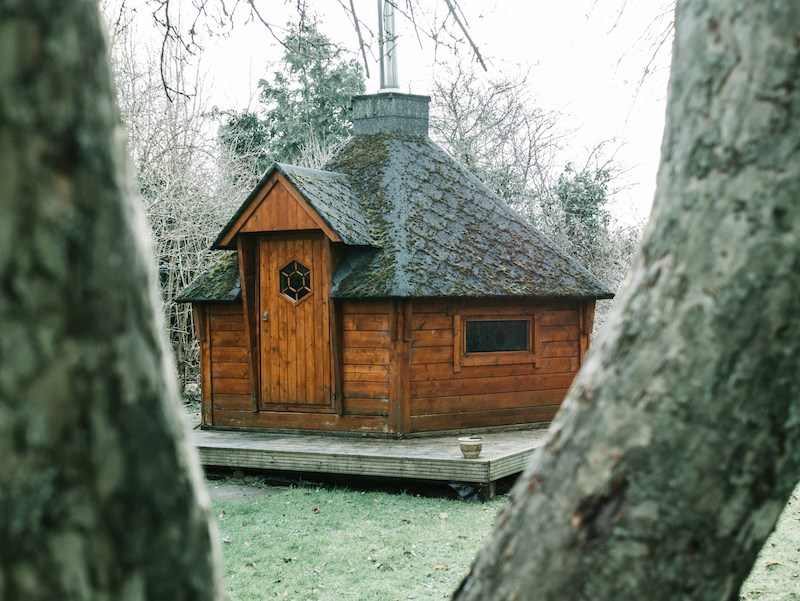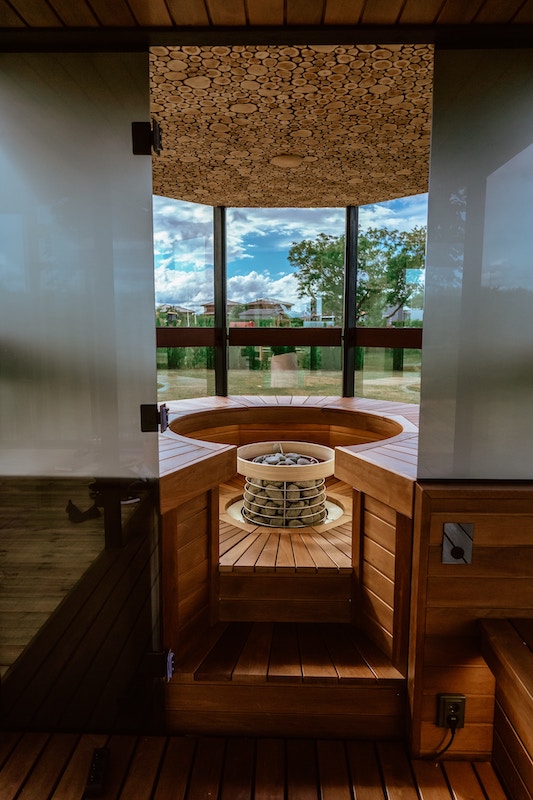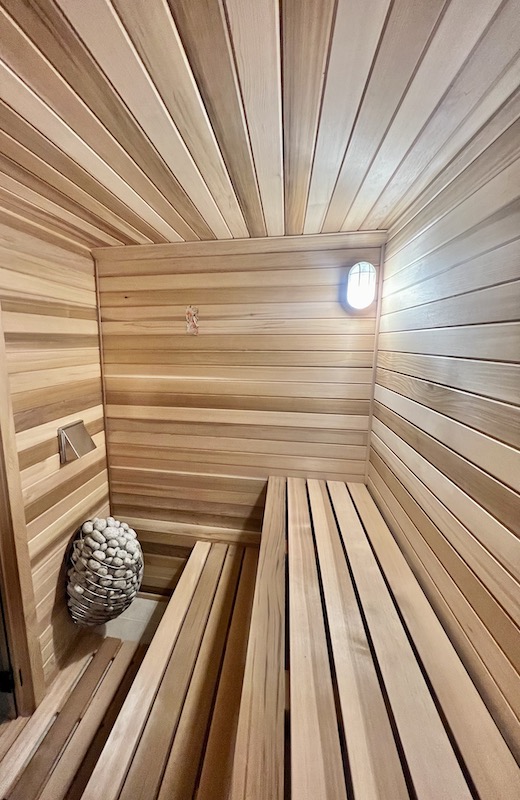A waterfall of sweat pouring down my body has become an enjoyable and meditative experience I look forward to each day. However, I realize not everyone would find this as gratifying as I do. While I cannot conclusively explain my love for traditional saunas, I can think of many potential reasons.
Maybe it’s the calming activities I engage in during these sweat sessions. I typically practice gratitude, read, converse with my husband about life (on the days he joins me), or just sit in silence with my thoughts.
Perhaps it’s the aesthetic of the room. I find the color and pattern variations of cedar quite beautiful, not to mention the addictive aroma the wood exudes.
Maybe the dry heat provides a nice contrast to the suffocating humidity I experienced growing up in the Southeast.

Or maybe I just have an inherent love for this ancient practice. I remember around the age of 10 our extended family took a vacation to Lake Tahoe. The large house we rented had a traditional sauna. I remember knowing about saunas, generally, but I had never experienced one and perhaps never even seen one.
I recall questioning why someone would want to sit in a small room, crank up the heat, and sweat. However, I stopped asking such questions after experiencing it for myself.
Even at that age, I found it quite pleasant and did it several times over the course of the week. I specifically remember enjoying the dry heat, smell of the wood, and the way I felt afterward.
Please note, sauna use is not recommended for those under the age of 16.
Regardless of why saunas appeal to me, I’m glad they do, especially considering the numerous health benefits they provide.
History of Traditional Saunas
Ancient History
Apparently, historians do not know where or when the first sauna existed. Different sources provide various possibilities.
According to this article, saunas originated in Africa shortly after humans discovered fire. Of course, these saunas by no means resemble what we think of as a traditional sauna nowadays.
Construction consisted of digging a hole in the ground the size of a grave and building a fire inside the hole. Then, it required placing poles over the opening to resemble a bed-like structure. Sick people would lay on the structure hoping to rid themselves of illness through the process of “sweating it out.”
According to another article, saunas likely originated in Northern Europe around 2,000 B.C. in man-made caves. The cave dwellers would burn a fire over a pile of stones and let the smoke waft out of the cave. The hot stones would keep people warm while they slept at night. The people who built these cave saunas believed that the smoke purified the caves. They viewed these “saunas” as holy places.
According to the same article, archeologists continue to discover evidence of ancient saunas in many areas of the world. For example, Native Americans built sweat lodges where they performed religious ceremonies.
More Recent History

Most people associate saunas with Finland, which makes sense given “sauna” is a Finnish word.
In fact, most sources estimate that Finland currently has about 3 million saunas, an astonishing number considering the total human population of only 5.5 million. Even small dwellings such as apartments often contain saunas.
The early saunas constructed in Northeastern Europe are referred to as “smoke saunas.” These dwellings did not contain chimneys, but fire served as the heat source. Therefore, the smoke would need to naturally dissipate before using the sauna. The process took about 6 hours. These smoke saunas still exist, and both the Finnish and Estonians (saunas have a similar history and tradition in Estonia) have a great reverence for them (source).
By the 1700s, sauna construction started to include chimneys. The fires, now burned in a stove, would heat a basket of rocks. The Finnish would often pour water over the rocks to increase humidity levels. Many Finnish people still use this type of sauna.

Then, around 1950, came the invention of the electric sauna. This significantly decreased the amount of time it took to heat up the sauna. While these modern saunas began in Finland, they became popular in other countries, including the United States.
Infrared Saunas
Infrared saunas, created in the late 1800s by John Harvey Kellogg, become available to the public in the late 1970s (source).
Essentially, infrared saunas work by using thermal radiation from light panels to heat the body directly, as opposed to the actual air. Infrared saunas cost less and often take up less space than traditional saunas, making them more accessible.
Additionally, they do not get as hot as traditional saunas, and because of the different heating element, they do not require dedicated real estate. For instance, infrared sauna tents and blankets have become increasingly popular.
Traditions Associated with Saunas
According to several articles I consulted, women often gave birth in saunas (not in high heat) because of their sterility. Traditionally, the Finnish also viewed saunas as a place for death, taking care of the sick, a winter dwelling, and a family gathering place. (source)
A traditional Finnish sauna experience requires HOT temperatures (212 degrees Fahrenheit). The Finnish enjoy the experience, typically with other people, for the purpose of relaxing and sweating. While they normally experience the sauna naked, I read that public saunas usually require bathing suits unless gender restricted.
Now, for the good part: During the winter, they often leave the sauna and immediately roll around in the snow or jump through ice into a freezing lake or other body of water (read this article about saying “yes” to a standard Finnish sauna experience).

A Traditional Sauna Activity
Another tradition, especially in the summer, involves the use of a viht or vasta or vihta. The first word is Estonian, and the second two are Finnish words, the difference depending on where in the country one chooses to sauna.
The English equivalent is thought to be “whisk.” Although, my inability to find much information on “whisks” is because, apparently, most English speakers have never heard of the concept. (source)
This article, published in an Estonian Sauna blog/magazine, provides a tutorial on how to make a viht or whisk. Essentially, it consists of a tree branch, typically birch, with a plentiful amount of mature, but fresh leaves.
Estonians and Finnish use the whisk to slap or beat all over the body while in the sauna. Allegedly, it cleanses the body, exfoliates skin, improves circulation, and relieves muscle pain. The blog post likens it to having a massage.
Vihad (plural form of viht) also fills the sauna with the fresh aroma of the tree. Interestingly, Estonians love vihad so much that one of their popular craft beers called ‘Sauna Session’ is made from it. They soak vihad in the water used to make the beer. (source)

My Experience with Whisks
When I first learned about this tradition, I could not help but laugh when envisioning my husband and I beating ourselves with tree branches in the sauna. But, who was I to question it? After all, the Finnish likely started the sauna tradition, and science has backed up many of their health claims.
While I had planned to eventually make my own whisk, my husband located some online. He purchased birch whisks. Per the instructions, we soaked the whisk in warm water (in our sauna bucket) prior to using it. We then took turns lightly slapping each other with the whisk, covering the entirety of the body (except our faces). We did this for five consecutive sauna sessions.
I thoroughly enjoyed the smell of the fresh birch emanating throughout the sauna. However, I did not enjoy picking up all the leaves that shed off the branches (from the impact of the “beating”). Overall, I would describe the scent as the most impactful and noticeable benefit. But it might require more than 5 sessions to notice other benefits.

Health Benefits of Traditional Saunas
Scientific studies have shown numerous health benefits associated with regular sauna use. High heat exposure causes hormesis – a stressor on the body, similar to that of exercise. Ultimately, this hormesis allows the body to better adapt to future stressors.
Dr. Rhonda Patrick wrote an extremely comprehensive article on her website explaining all the health benefits and citing the scientific studies. I recommend checking it out if you want a more in-depth understanding of the science. However, here is a more abbreviated summary of the benefits:
1. Improves Cardiovascular Health
Sauna use, especially at high temperatures, provides similar benefits to exercise. A large study performed on Finnish men found that those who use a sauna 2-3 times per week are 22% less likely to experience sudden cardiac death. More notably, those who use it 4-7 times per week are 63% less likely to experience sudden cardiac death. Additionally, regular sauna use may mitigate or prevent hypertension.
2. Reduces Inflammation
C-reactive protein, a blood protein associated with inflammation and the development of atherosclerosis (plaque buildup in the artery walls) and cardiac events, occurred at lower levels in those who participate in frequent sauna use.
3. Cognitive Benefits
The same study of Finnish men addressed above found that those who use a sauna 4-7 times per week have a 65% reduced risk of developing Alzheimer’s disease compared to those who used it only one time per week.
Sauna use also increases norepinephrine and prolactin, hormones that assist with mental focus and attention span.

4. Improves Mood
This article from Huberman Lab explains that high heat exposure will release endorphins that produce a “mild, happy euphoria.” Regular sauna use can also decrease cortisol, a stress hormone.
Additionally, sauna use mitigates depression, and the results speak for themselves: 30 healthy adults exposed to one session of heat that elevated their core body temperature to 101.3 resulted in an anti-depressant effect that lasted for six weeks after the session.
5. Increases Heat Shock Proteins
I lacked familiarity with heat shock proteins prior to my research on sauna use, but this benefit really intrigued me. Basically, heat shock proteins are essential in many cellular processes, including immune function. An increase in heat shock proteins can repair damaged protein structures in our cells.
This is important because damaged and/or disordered proteins are associated with diseases such as Alzheimer’s, Parkinsons, and Hunington’s disease, as well as cardiovascular diseases.
6. Metabolic Benefits
A study performed on mice exposed to a far-infrared sauna for 30 minutes three times per week for 12 weeks resulted in significantly lower fasting blood glucose levels.
Sauna use also potentially increases physical fitness and muscle mass maintenance.
Check out my post on metabolic health for an explanation on how muscle mass improves metabolic function.

7. Detoxification
Sauna use results in heavy sweating which may rid the body of toxins, including heavy metals, BPA, and phthalate compounds.
8. Reduces Likelihood of Death from All Causes
Astoundingly, the study on Finnish men (referenced above) found that frequent sauna users (4-7 times per week) are “37% less likely to die from all causes of premature death, regardless of age, activity levels and lifestyle factors.”
Importantly, many of the foregoing benefits occurred from regular sauna use (a minimum of twice per week, and ideally 4+ times per week) at quite toasty temperatures of 176-212 degrees Fahrenheit for around 20 minutes per session.
Source: https://www.foundmyfitness.com/topics/sauna#bibid-773bf56688b45fce507f783dfd3f01f2
Safety Precautions
Please refer to Dr. Rhonda Patrick’s article, as well as this article, for a summary of precautions associated with sauna use, but essentially pregnant women and children should avoid saunas, as well as those with a diagnosed cardiovascular condition.
Also, remember to stay properly hydrated! You will sweat a lot in the sauna! Please take caution to replenish electrolytes as well.
My At-Home Traditional Sauna Experience
While I have always loved saunas, I became particularly intrigued after listening to a Huberman Lab podcast episode with Dr. Rhonda Patrick.
During the episode, she explained that using a sauna in graduate school greatly reduced her anxiety. Her story made me wish that I had access to a sauna while in law school. Even now, I struggle with anxiety at times.
Dr. Patrick also explained other benefits of regular sauna use, which I subsequently researched on my own. Thereafter, my husband and I considered joining a local racket club with a sauna. However, we ultimately concluded that leaving the house to access it meant we likely would not use it often enough.
In considering both traditional and infrared saunas for our house, we settled on a traditional sauna, because the scientific studies touting the numerous health benefits relied on traditional saunas.
Heat levels most notably distinguish the two — traditional saunas max out between 190 and 215 degrees, whereas infrared saunas typically do not exceed 150 degrees. Most of the studies used temperatures between 176 and 212 degrees (Fahrenheit).

At first, we considered purchasing a stand-alone traditional sauna online. But, given the hefty price and small size, we ended up building our own.
Luckily, we had a large, finished storage closet off our bonus room with nearly perfect dimensions for a sauna. We both searched for DIY guidance/instructions but found quality information quite sparse. Fortunately, my husband has extensive construction experience.
When building our sauna, we had to select a cedar supplier and a manufacturer for the heating element. After conducting research, we purchased a custom, cedar indoor sauna kit from BsaunasUSA. For the electric heater, we chose HUUM.
We had a great experience with Bsaunas. They had affordable prices, and with the exception of a few boards, they sent high quality cedar. For the few pieces that lacked quality or were damaged, they sent replacements, free of charge, without any hassle.

We also like our HUUM heater, but we have had some issues with it. We purchased their DROP electric heater.
While it looks quite beautiful, the rocks shed quite a bit. The discarded rock flakes pile up under the heater, which requires more frequent sauna cleanings.
We have also had issues with the thermostat, as it did not project the temperature accurately. After much trial and error, moving it around the sauna, and requesting a replacement, it finally reads more accurately than it initially did.
My Daily Traditional Sauna Ritual (including temperature and time)
I use the sauna almost every day. Typically, I set the thermostat in the 175-185 degree range and stay in for 30 minutes. Initially, I started with a temperature around 160 degrees and worked my way up to the current range.
Everyone’s body is different, and some people handle heat better than others. I handle it well and typically have no problem staying in for 30 minutes.

While in the sauna, I typically read, write, or just focus on my breathing and process my day or the current thoughts running in my head.
I prefer to use the sauna in the late afternoon and evening hours. I find it a very desirable way to wind down and prepare my body for sleep. It produces a sense of calmness.
While I occasionally use the sauna during the day after exercise to increase the cardiovascular benefits of the exercise (basically to keep my heart rate elevated for a longer period of time), I find that it almost calms me down too much to subsequently move on with my day and maintain high energy levels. To me, it has the opposite effect of cold plunging.
I have also tried the mentally and physically demanding Finnish challenge of going from the sauna directly into cold water.
While I wouldn’t describe it as torturous, I would rather skip the cold water afterward, especially since I like to use hot and cold therapy at different times of the day. That said, I have heard and read about health benefits associated with using them back-to-back.

Despite the substantial investment (cedar and sauna heaters are EXPENSIVE), I have zero regrets about building a sauna in our house. Having a therapeutic, luxurious way to wind down each day, not to mention the numerous health benefits, makes the steep cost worth it!
Choosing A Sauna
If anyone has questions about how we built our sauna, including general construction, dimensions, electrical elements, airflow mechanisms, etc., I am more than happy to answer them!
For a non-custom stand alone sauna, here are some options we considered:
- Almost Heaven Grayson 4-Person Indoor Sauna from Select Saunas. Select Saunas offers a plethora of options and many custom selections.
If you do not have the space or budget for a traditional sauna, I know people with infrared saunas who love them.
Even a newer option like a sauna blanket could produce at least some of the benefits described above, especially if you can get it to a temperature that causes profuse perspiration.
Here are some promising options:
Medical Disclaimer: I am not a physician or a medical professional. The content shared on this jessicatrone.com is for informational purposes only, is not a substitute for the advice of medical doctors and should not be used to prevent, diagnose, or treat any condition. Consult with a physician prior to beginning any fitness, health, or wellness regimen or routine. The content on jessicatrone.com is based on the opinion and personal experiences of its author and is solely for educational and informational purposes. Jessicatrone.com is not liable for how you choose to implement and use the information contained in it.
What do you think about saunas?
Do you ever use them?
What health benefits do you find most appealing?
Do you have any questions about how to build a custom sauna in your house?

be the first to comment